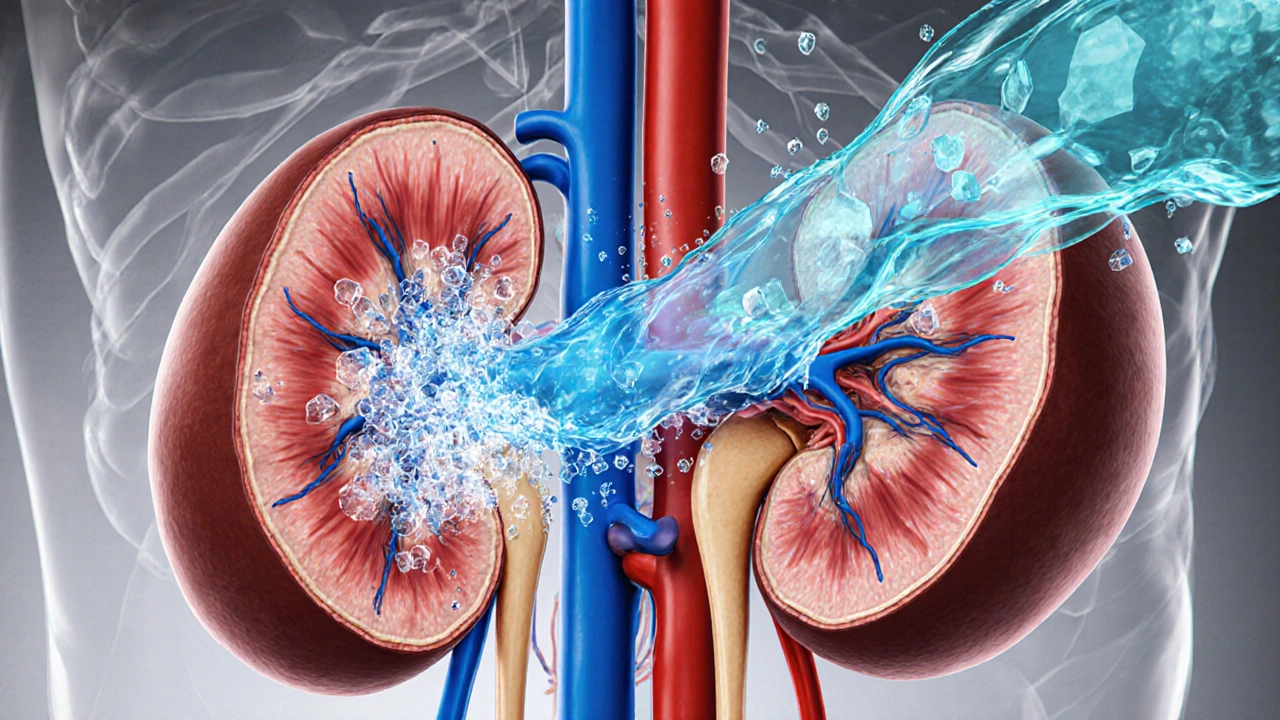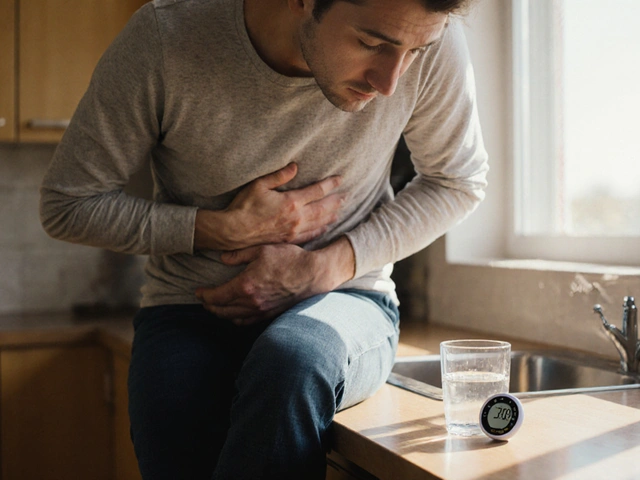
Gout & Hydration Calculator
Daily Water Intake Recommendation
This calculator estimates your daily water intake needs to help manage gout and maintain optimal hydration.
Your Results
Enter your details and click "Calculate Recommended Water Intake" to see your personalized hydration plan.
Hydration Progress
Track your daily water consumption
Tips for Better Hydration
- Drink 500ml of water upon waking
- Carry a reusable water bottle
- Flavor water with citrus or cucumber
- Eat water-rich fruits and vegetables
- Limit caffeine and alcohol
Ever wondered why a simple glass of water can feel like a secret weapon against a painful gout flare? The link between gout and dehydration is stronger than most people think, and staying properly hydrated can cut down attacks, speed up recovery, and keep uric‑acid levels in check.
What is gout and how dehydration fuels it
Gout is a form of arthritis caused by the buildup of uric acid crystals in joints. When uric acid crystals lodge in the big toe, ankle, or knee, the joint swells, turns red, and hurts like fire.
Dehydration occurs when the body loses more fluid than it takes in, reducing the volume of blood plasma. Less plasma means the blood becomes more concentrated, and the concentration of uric acid rises.
The kidneys, which filter waste, rely on enough water to flush out excess uric acid. When you’re dehydrated, the kidneys can’t excrete uric acid efficiently, so it stays in the bloodstream, ready to crystalise.
Key players: uric acid, kidneys and fluid balance
Uric acid is a by‑product of breaking down purines-molecules found in meat, seafood, and some vegetables. In a well‑hydrated body, uric acid dissolves in the blood and is carried to the kidneys for removal.
Kidney function is directly tied to fluid intake. Each litre of water you drink helps the kidneys filter roughly 150‑200ml of blood per minute. When fluid intake drops, the filtration rate slows, and uric‑acid clearance drops accordingly.
Think of it like a coffee filter: if the water flow is weak, the grounds (uric acid) stay trapped and eventually clump together.
Spotting the difference: gout symptoms vs dehydration signs
Both conditions can cause fatigue and a general feeling of being "off," but they manifest differently:
- Gout attack: Sudden, intense pain in a joint, swelling, warmth, and a shiny red skin surface. The pain often peaks within the first 12hours.
- Dehydration signs: Dark‑yellow urine, dry mouth, dizziness, and muscle cramps. Joint pain from dehydration is usually mild and diffuse, not the sharp stabbing sensation of gout.
If you notice a flare‑up alongside dark urine and a sticky‑feeling mouth, you’re probably dealing with both at once-time to hydrate fast.

How much water should you really drink?
General guidelines suggest 2.7L per day for women and 3.7L for men, including fluids from food. For gout patients, the goal is to keep uric‑acid concentration below 6mg/dL (women) or 7mg/dL (men). A simple rule of thumb is:
- Start the day with 500ml (about two cups) of water.
- Drink another 250ml before each meal.
- Carry a 250ml bottle and sip every 30minutes, especially if you’re active or live in a warm climate.
If you’re sweating a lot, add an extra 500‑1000ml. The key is consistency-not just gulping a large glass once.
| Group | Baseline Recommendation | Additional Intake for Gout Management |
|---|---|---|
| Adult Women (≤60kg) | 2.7L | +0.5L |
| Adult Women (>60kg) | 2.9L | +0.7L |
| Adult Men (≤80kg) | 3.7L | +0.8L |
| Adult Men (>80kg) | 4.0L | +1.0L |
These extra litres help dilute uric acid and give the kidneys a better chance to flush it out.
Practical ways to stay hydrated
- Keep a reusable water bottle on your desk. Seeing it reminds you to sip.
- Flavor water with a slice of citrus or cucumber if plain water feels boring.
- Eat water‑rich foods: watermelon, cucumbers, oranges, and soups add roughly 100‑200ml per serving.
- Limit caffeine and alcohol. Both act as diuretics, pulling fluid out of your cells.
- Consider electrolyte drinks during intense workouts, but choose low‑sugar options to avoid extra purines.
Diet, lifestyle and medication: the hydration synergy
Purines are found in red meat, organ meats, and some seafood. Cutting back reduces uric‑acid production.
Alcohol, especially beer, adds both purines and a dehydrating effect. Switching to water‑based beverages can cut flare‑ups by up to 30% according to a 2023 clinical observation.
Medications like Allopurinol lower uric‑acid production, while Colchicine reduces inflammation during an attack. Both work best when the body is well‑hydrated; dehydration can increase drug side‑effects and reduce their efficacy.
Combine medication adherence with the hydration plan above, and you’ll see fewer, milder attacks.
Quick gout‑and‑hydration checklist
- Drink 500ml of water within 30minutes of waking.
- Carry a 250ml bottle and sip every half hour.
- Avoid >2standard drinks of alcohol per week.
- Limit high‑purine foods to <2 servings per week.
- Take prescribed gout medication with a full glass of water.
- Check urine colour daily - aim for light straw yellow.
Follow this list for at least two weeks and note any change in attack frequency.

Frequently Asked Questions
Can drinking too much water worsen gout?
Generally, more water helps dilute uric acid, but excessive intake (over5L per day) can strain the kidneys and dilute electrolytes. Aim for the recommended range plus a modest extra if you’re active.
Is sparkling water okay for gout patients?
Yes, as long as it’s plain and unsweetened. Carbonation doesn’t affect uric‑acid levels, but added sugars or flavors can raise calorie intake and indirectly affect weight, a gout risk factor.
How quickly does hydration impact a gout flare?
Within a few hours, increased fluid volume can start lowering serum uric‑acid concentration. Most patients notice reduced pain intensity after 24‑48hours of adequate hydration combined with medication.
Do I need to track my water intake?
Tracking helps build the habit, especially during busy weeks. Use a phone app or a marked bottle to ensure you meet the daily target.
Should I avoid coffee if I have gout?
Moderate coffee (1‑2 cups) is fine for most gout sufferers. High caffeine can have a mild diuretic effect, so balance it with extra water.
19 Comments
faith long
October 7, 2025 AT 16:00 PM
I hear you loud and clear – dehydration is a silent assassin that sneaks up on anyone dealing with gout, and it’s infuriating how many people just ignore the science and keep guzzling sugary drinks. Every time you skip that morning glass of water, you’re essentially telling your kidneys to work overtime, and that’s a betrayal you don’t deserve. The article’s calculator is a solid step forward, but we need to shout louder about the consequences of neglecting hydration: chronic pain, missed workdays, and a lowered quality of life. Don’t let the convenience of a soda win over the simple act of drinking water; it’s an aggressive battle for your health and you need to win. Hydration isn’t a suggestion; it’s a non‑negotiable demand you place on yourself, especially when gout threatens to derail your daily routine. So crank up the water intake, track it like a boss, and never let yourself slip back into the dehydrated abyss again.
Adam Khan
October 10, 2025 AT 05:06 AM
The piece suffers from a lamentable paucity of precision, employing colloquial vernacular where a scrupulous exposition of renal uric clearance would be more apt. One must underscore that the osmolarity of plasma is directly proportional to solute concentration; thus, inadequate water ingestion precipitates hyperuricemia via hemoconcentration – a fact that should not be relegated to a mere footnote. Moreover, the calculator’s algorithm appears to neglect the influence of dietary purine load, a variable of paramount importance in a nation where meat consumption is emblematic of cultural identity. It would behoove the authors to integrate a multivariate regression model accounting for variables such as GFR, BMI, and even regional dietary patterns. In its current state, the tool is a superficial trinket, insufficient for the discerning individual seeking an evidence‑based approach to gout prophylaxis. Finally, let us not overlook the imperative to standardize measurement units; the article oscillates between metric and imperial without justification, compromising scientific rigor.
rishabh ostwal
October 12, 2025 AT 18:13 PM
While the intention behind promoting hydration is commendable, one must question the underlying assumptions that render the calculator a mere parlor trick rather than a robust clinical instrument. The discourse neglects to address the socioeconomic disparities that impede access to potable water, an oversight that borders on moral indifference. In a world where gout afflicts both the affluent and the indigent, reducing its management to a spreadsheet of water ounces feels both reductive and disingenuous. Furthermore, the omission of a comprehensive dietary analysis betrays a simplistic worldview that fails to acknowledge the complex interplay of purines, alcohol, and fructose. I implore the authors to elevate their work beyond anecdotal recommendations and to anchor it firmly within a framework of holistic, evidence‑based medicine.
Kristen Woods
October 15, 2025 AT 07:20 AM
Ths articl presents a valuble tool for patints sooking to maange gout through proper hydrtion. However, the guidlines omet some crutial points such as the impact of caffeine on uric acid levels. It would be apprciated if the devlopers could incude a secton on diuretic substances that may counderact the benefits of water intake. Despite these omissins, the calculator is a step in the rigt direction for patient empowerment. I suggst adding a disclaimer about consulting a health profssional before making dramtic changes to fluid consumption.
Carlos A Colón
October 17, 2025 AT 20:26 PM
Oh sure, just drink water and all your gout problems magically disappear-because we all love instant miracles.
Aurora Morealis
October 20, 2025 AT 09:33 AM
Hydration is key to flushing uric acid keep a water bottle handy and sip steadily throughout the day
Sara Blanchard
October 22, 2025 AT 22:40 PM
Everyone, regardless of age or gender, can benefit from drinking enough water; think of it as a universal health equalizer that helps the body eliminate excess uric acid and supports kidney function.
Anthony Palmowski
October 25, 2025 AT 11:46 AM
Water is life!!!
Jillian Rooney
October 28, 2025 AT 00:53 AM
i think its also important to consider that not everyone has easy access to clean water and that the article could have mentioned some low‑cost alternatives like boiled tap water or filtered solutions.
Rex Peterson
October 30, 2025 AT 14:00 PM
From a philosophical standpoint, the act of hydration transcends mere physiological necessity; it embodies a deliberate engagement with one's own corporeal limits, urging the individual to cultivate a disciplined routine that mitigates the stochastic emergence of gout flares.
Candace Jones
November 2, 2025 AT 03:06 AM
Building on that thought, incorporating consistent water intake into daily habits can serve as a tangible anchor, providing measurable progress that reinforces the broader philosophical commitment to self‑care.
Robert Ortega
November 4, 2025 AT 16:13 PM
Both perspectives highlight valid points: the calculator offers practical guidance, yet integrating broader lifestyle factors would enhance its utility.
Elizabeth Nisbet
November 7, 2025 AT 05:20 AM
Just remember, you don't have to chug gallons at once-steady sips add up and keep those uric acid levels in check.
Sydney Tammarine
November 9, 2025 AT 18:26 PM
Oh my gosh, can we talk about how dramatically my life changed after I finally started tracking my water intake? 😱 It's like my joints threw a gratitude party and the pain finally RSVP'd "nope"! 🌟
josue rosa
November 12, 2025 AT 07:33 AM
When dissecting the pathophysiology of gout, one must appreciate the intricate cascade wherein purine catabolism culminates in the generation of uric acid, a solute whose solubility is exquisitely sensitive to the physicochemical milieu of the extracellular fluid. Hydration exerts a pivotal modulatory effect by augmenting plasma volume, thereby diluting urate concentration and enhancing glomerular filtration rate (GFR), which collectively foster renal excretion of uric acid. Empirical evidence corroborates that individuals adhering to individualized water intake thresholds-derived from variables such as body mass index (BMI), metabolic rate, and activity quantum-exhibit a statistically robust decrement in serum urate levels, translating to a lower incidence of monosodium urate crystal deposition within synovial spaces. Moreover, the interplay between hydration and uric acid homeostasis is further nuanced by the influence of concomitant dietary constituents, notably fructose and alcohol, which may potentiate de novo purine synthesis or impede renal clearance, respectively. Consequently, a comprehensive gout management protocol should not merely prescribe a generic volumetric intake but should integrate a dynamic, algorithmic approach-potentially leveraging machine learning classifiers-to tailor fluid recommendations in real time, accounting for fluctuations in physical exertion, ambient temperature, and individual renal function metrics. In practice, clinicians ought to counsel patients on pragmatic strategies such as scheduled water breaks, utilization of hygroscopic beverage containers, and the inclusion of hydrating foods-cucumbers, watermelon, and celery-to synergistically augment total fluid consumption. By embracing this multifaceted, evidence‑based hydration paradigm, the medical community can substantially mitigate the burden of gout flares and enhance patient quality of life.
Angie Wallace
November 14, 2025 AT 20:40 PM
Great overview – staying hydrated really does make a difference.
Doris Montgomery
November 17, 2025 AT 09:46 AM
Meh, the calculator is okay but nothing groundbreaking.
Nick Gulliver
November 19, 2025 AT 22:53 PM
Honestly, it's surprising that a simple habit like drinking water gets more hype than some of the big pharma solutions our country pushes.






Trinity 13
October 5, 2025 AT 02:53 AM
Staying hydrated is literally the cornerstone of keeping gout under control, and it's not just some fluffy advice that nutritionists throw around for the sake of sounding wise. When you drink enough water, your kidneys can flush out uric acid more efficiently, which means fewer painful crystal attacks in your joints. Think about it like a highway system: the more fluid you have, the smoother the traffic of metabolic waste moves, and the less likely you are to hit a traffic jam that manifests as that excruciating throbbing in your toe. Moreover, dehydration makes the blood more concentrated, raising serum urate levels and setting the stage for those nasty monosodium urate deposits. If you’ve ever woken up with a sudden flare, consider whether you skipped that 500 ml glass you were supposed to drink first thing in the morning. Studies have shown that people who consistently meet their individualized water intake recommendations experience a statistically significant reduction in gout flare frequency. The calculator in the article does a decent job of personalizing that target based on weight, gender, and activity, which is far better than the one-size-fits-all “8 glasses a day” myth. Additionally, staying hydrated supports overall kidney health, which is crucial because compromised kidneys can’t excrete uric acid effectively. It’s also worth noting that sugary sodas and alcohol not only dehydrate you but also add purines that further elevate uric acid levels. Swapping those for water, infused with a slice of lemon or cucumber, can make the habit more enjoyable while still delivering those hydration benefits. Finally, remember that consistency trumps occasional binge‑drinking; sipping water throughout the day keeps your urine dilute and your urate levels in check. So grab your reusable bottle, set reminders if you have to, and make hydration a non‑negotiable part of your gout management plan.